
上游充通大 GHAI JIAO TONG UNIVERST T SHANGHAI JIAOTONG UNIVERSITY How Do College Students'Biorhythm and Sleep Habits Affect the Quality of Sleep Miguang Sun,Zihao Ding,Yihui Hu An Article Submitted to Prof.Li Zhang For the course of Academic Communication in English 2016.5.20
SHANGHAI JIAOTONG UNIVERSITY How Do College Students’ Biorhythm and Sleep Habits Affect the Quality of Sleep An Article Submitted to Prof. Li Zhang For the course of Academic Communication in English 2016.5.20 Miguang Sun,Zihao Ding,Yihui Hu

上游充通大¥ SHANGHAI JIAO TONG UNIVERSIT ACIE Group 7 How do College Students'Biorhythm and Sleep Habits Affect the Quality of Sleep Miguang Sun',Zihao Ding2,Yihui Hu3 ISchool of Materials Science and Engineering,Shanghai Jiao Tong University School of Materials Science and Engineering,Shanghai Jiao Tong University 3School of Materials Science and Engineering,Shanghai Jiao Tong University Abstract A lot of researches have been done to conclude effects of different patterns and habits on people's quality of sleep and it is clear that people in similar environment share similar biorhythm and sleep habits. However,little attention has been focused on college students,who are so special and different from other groups of people.Aiming at understanding the effect of college students'biorhythm and sleep habits on the quality of sleep,questionnaire and hands-on experiments are conducted in this research project.Results suggest that most college students have unique sleep pattern compared to other groups of people.In addition,we can see that several biorhythm and sleep habits can cause some positive or negative effects on our quality of sleep,which gives us guidance on how to improve college students'quality of sleep. Key words:sleep pattern,biorhythm,sleep habits -1-
ACIE Group 7 - 1 - How do College Students’ Biorhythm and Sleep Habits Affect the Quality of Sleep Miguang Sun 1 , Zihao Ding2 , Yihui Hu3 1School of Materials Science and Engineering, Shanghai Jiao Tong University 2School of Materials Science and Engineering, Shanghai Jiao Tong University 3School of Materials Science and Engineering, Shanghai Jiao Tong University Abstract A lot of researches have been done to conclude effects of different patterns and habits on people’s quality of sleep and it is clear that people in similar environment share similar biorhythm and sleep habits. However, little attention has been focused on college students, who are so special and different from other groups of people. Aiming at understanding the effect of college students’ biorhythm and sleep habits on the quality of sleep, questionnaire and hands-on experiments are conducted in this research project. Results suggest that most college students have unique sleep pattern compared to other groups of people. In addition, we can see that several biorhythm and sleep habits can cause some positive or negative effects on our quality of sleep, which gives us guidance on how to improve college students’ quality of sleep. Key words: sleep pattern, biorhythm, sleep habits

上充廷大¥ SHANGHAI JIAO TONG UNIVERSIT ACIE Group 7 Table of Contents! 1.Introduction.… 4 2.Theoretical Framework and Literature Review. .4 2.1.The Importance of Healthy Sleep Patterns. 2.2.The Factors that Influence the Quality of Sleep. .4 2.3.The Limitation and Questions........................... 6 3.Methodology.… 6 3.1.Research design................ 1 3.2.Participants........... 7 3.3.Instrument........... 8 3.4.Data collection. 9 4.Results.… 10 4.1.Questionnaires............... 10 4.1.1.Biorhythm.… 10 4.1.2.Sleep habits............. 11 4.1.3.Sleep problems....... 12 4.2.Hands-on experiments................. 13 4.2.1.Experiments related to biorhythm. 14 4.2.2.Experiment related to sleep habits 15 5.Discussion........... 16 5.1.Sleep patterns of college students................... 16 5.2.Scientific discussions for experiments............................. 16 5.2.1.Persistent stay-up............... 17 5.2.2.Keeping early hours...... 18 5.2.3.Nap tests...... 18 5.2.4.Cell phone playing 19 5.2.5.Exercising..… 20 5.2.6.Milk drinking. 21 5.3.Suggestions… 21 6.C0 nclusion.… 22 7.Appendix.… 。。。。。。。。。。。,。。。。。。。。。 22 Part3,5,6 and 7 were written by Miguang Sun,abstract and part 2 were written by Zihao Ding,part 1 and 4 were written by Yihui Hu.They contributed equally to the review parts of the article. -2-
ACIE Group 7 - 2 - Table of Contents1 1. Introduction...........................................................................................4 2. Theoretical Framework and Literature Review........................... .........4 2.1. The Importance of Healthy Sleep Patterns....................................4 2.2. The Factors that Influence the Quality of Sleep............................4 2.3. The Limitation and Questions.......................................................6 3. Methodology..........................................................................................6 3.1. Research design.............................................................................7 3.2. Participants................................................................................... 7 3.3. Instrument......................................................................................8 3.4. Data collection...............................................................................9 4. Results.................................................................................................10 4.1. Questionnaires.............................................................................10 4.1.1. Biorhythm..........................................................................10 4.1.2. Sleep habits........................................................................11 4.1.3. Sleep problems..................................................................12 4.2. Hands-on experiments.................................................................13 4.2.1. Experiments related to biorhythm....................................14 4.2.2. Experiment related to sleep habits....................................15 5. Discussion...........................................................................................16 5.1. Sleep patterns of college students................................................16 5.2. Scientific discussions for experiments.........................................16 5.2.1. Persistent stay-up..............................................................17 5.2.2. Keeping early hours..........................................................18 5.2.3. Nap tests...........................................................................18 5.2.4. Cell phone playing............................................................19 5.2.5. Exercising.........................................................................20 5.2.6. Milk drinking....................................................................21 5.3. Suggestions....................................................................................21 6. Conclusion...........................................................................................22 7. Appendix.............................................................................................22 1 Part3, 5, 6 and 7 were written by Miguang Sun, abstract and part 2 were written by Zihao Ding, part 1 and 4 were written by Yihui Hu.They contributed equally to the review parts of the article
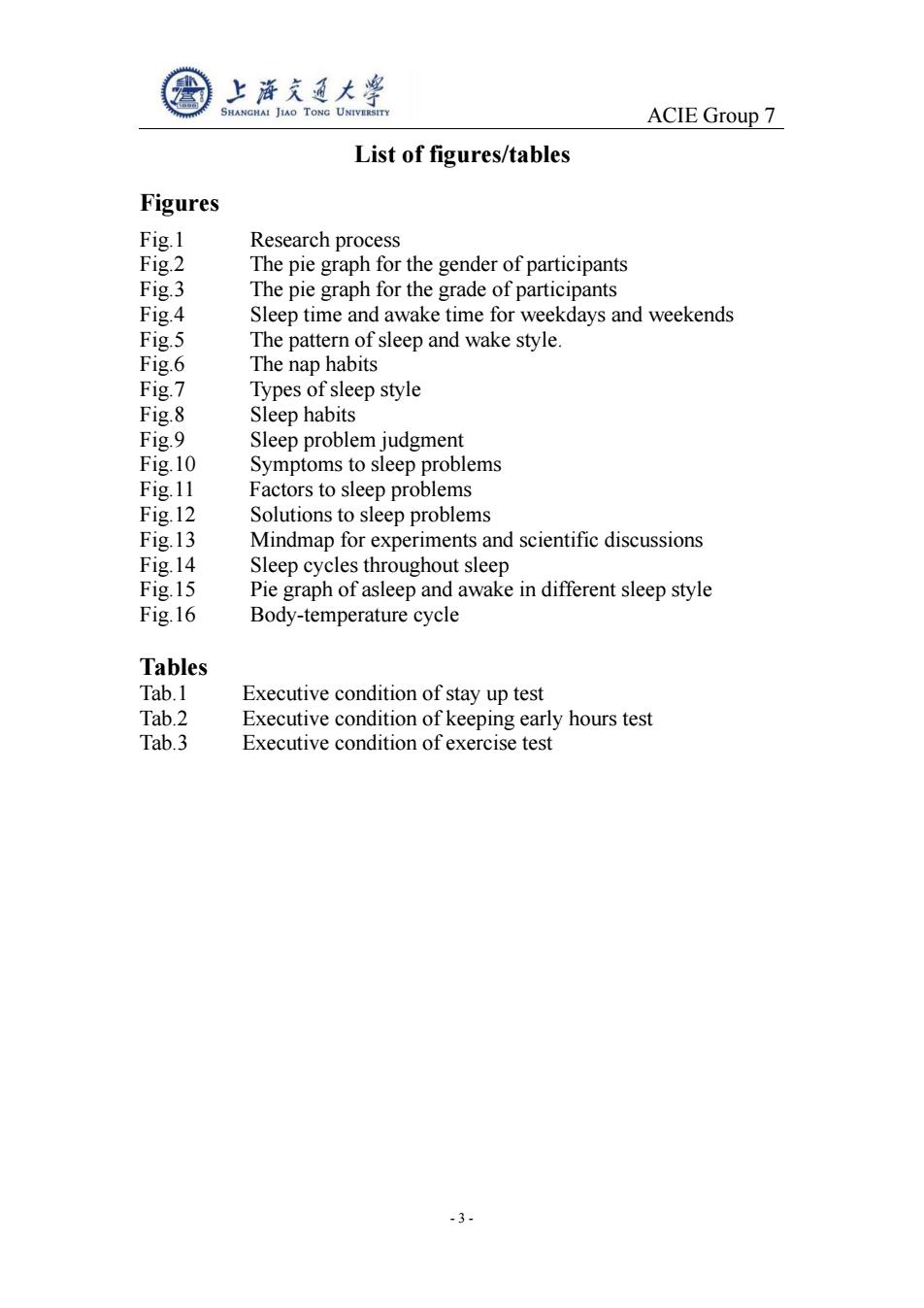
上游充廷大¥ SHANGHAI JIAO TONG UNIVERSIT ACIE Group 7 List of figures/tables Figures Fig.1 Research process Fig.2 The pie graph for the gender of participants Fig.3 The pie graph for the grade of participants Fig.4 Sleep time and awake time for weekdays and weekends Fig.5 The pattern of sleep and wake style. Fig.6 The nap habits Fig.7 Types of sleep style Fig.8 Sleep habits Fig.9 Sleep problem judgment Fig.10 Symptoms to sleep problems Fig.11 Factors to sleep problems Fig.12 Solutions to sleep problems Fig.13 Mindmap for experiments and scientific discussions Fig.14 Sleep cycles throughout sleep Fig.15 Pie graph of asleep and awake in different sleep style Fig.16 Body-temperature cycle Tables Tab.1 Executive condition of stay up test Tab.2 Executive condition of keeping early hours test Tab.3 Executive condition of exercise test -3-
ACIE Group 7 - 3 - List of figures/tables Figures Fig.1 Research process Fig.2 The pie graph for the gender of participants Fig.3 The pie graph for the grade of participants Fig.4 Sleep time and awake time for weekdays and weekends Fig.5 The pattern of sleep and wake style. Fig.6 The nap habits Fig.7 Types of sleep style Fig.8 Sleep habits Fig.9 Sleep problem judgment Fig.10 Symptoms to sleep problems Fig.11 Factors to sleep problems Fig.12 Solutions to sleep problems Fig.13 Mindmap for experiments and scientific discussions Fig.14 Sleep cycles throughout sleep Fig.15 Pie graph of asleep and awake in different sleep style Fig.16 Body-temperature cycle Tables Tab.1 Executive condition of stay up test Tab.2 Executive condition of keeping early hours test Tab.3 Executive condition of exercise test
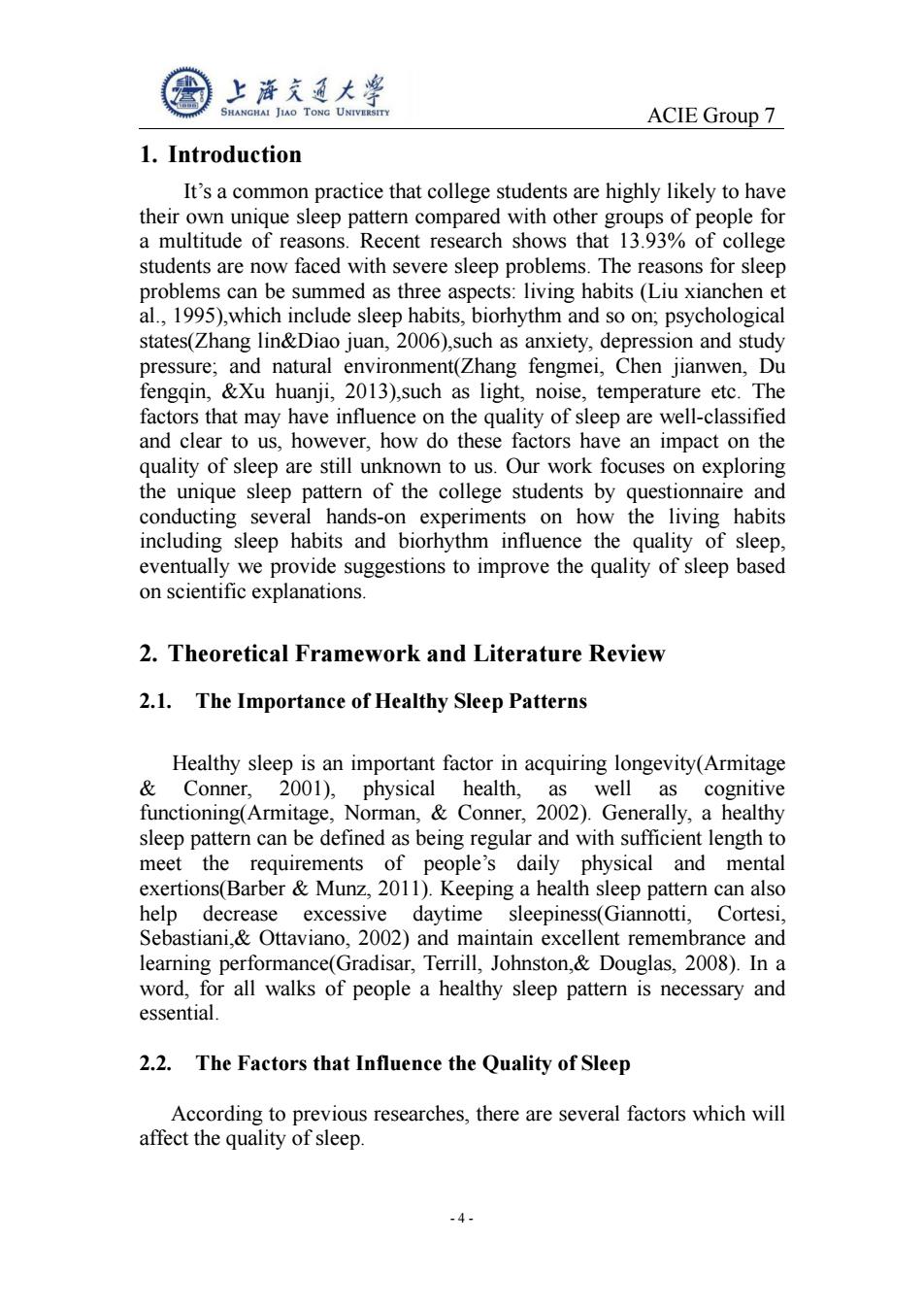
上降气通大学 SHANGHAI JIAO TONG UNIVERSIT ACIE Group 7 1.Introduction It's a common practice that college students are highly likely to have their own unique sleep pattern compared with other groups of people for a multitude of reasons.Recent research shows that 13.93%of college students are now faced with severe sleep problems.The reasons for sleep problems can be summed as three aspects:living habits(Liu xianchen et al.,1995),which include sleep habits,biorhythm and so on;psychological states(Zhang lin&Diao juan,2006),such as anxiety,depression and study pressure;and natural environment(Zhang fengmei,Chen jianwen,Du fengqin,&Xu huanji,2013),such as light,noise,temperature etc.The factors that may have influence on the quality of sleep are well-classified and clear to us,however,how do these factors have an impact on the quality of sleep are still unknown to us.Our work focuses on exploring the unique sleep pattern of the college students by questionnaire and conducting several hands-on experiments on how the living habits including sleep habits and biorhythm influence the quality of sleep, eventually we provide suggestions to improve the quality of sleep based on scientific explanations. 2.Theoretical Framework and Literature Review 2.1.The Importance of Healthy Sleep Patterns Healthy sleep is an important factor in acquiring longevity(Armitage Conner,2001),physical health,as well as cognitive functioning(Armitage,Norman,&Conner,2002).Generally,a healthy sleep pattern can be defined as being regular and with sufficient length to meet the requirements of people's daily physical and mental exertions(Barber Munz,2011).Keeping a health sleep pattern can also help decrease excessive daytime sleepiness(Giannotti,Cortesi, Sebastiani,&Ottaviano,2002)and maintain excellent remembrance and learning performance(Gradisar,Terrill,Johnston,Douglas,2008).In a word,for all walks of people a healthy sleep pattern is necessary and essential. 2.2.The Factors that Influence the Quality of Sleep According to previous researches,there are several factors which will affect the quality of sleep -4
ACIE Group 7 - 4 - 1. Introduction It’s a common practice that college students are highly likely to have their own unique sleep pattern compared with other groups of people for a multitude of reasons. Recent research shows that 13.93% of college students are now faced with severe sleep problems. The reasons for sleep problems can be summed as three aspects: living habits (Liu xianchen et al., 1995),which include sleep habits, biorhythm and so on; psychological states(Zhang lin&Diao juan, 2006),such as anxiety, depression and study pressure; and natural environment(Zhang fengmei, Chen jianwen, Du fengqin, &Xu huanji, 2013),such as light, noise, temperature etc. The factors that may have influence on the quality of sleep are well-classified and clear to us, however, how do these factors have an impact on the quality of sleep are still unknown to us. Our work focuses on exploring the unique sleep pattern of the college students by questionnaire and conducting several hands-on experiments on how the living habits including sleep habits and biorhythm influence the quality of sleep, eventually we provide suggestions to improve the quality of sleep based on scientific explanations. 2. Theoretical Framework and Literature Review 2.1. The Importance of Healthy Sleep Patterns Healthy sleep is an important factor in acquiring longevity(Armitage & Conner, 2001), physical health, as well as cognitive functioning(Armitage, Norman, & Conner, 2002). Generally, a healthy sleep pattern can be defined as being regular and with sufficient length to meet the requirements of people’s daily physical and mental exertions(Barber & Munz, 2011). Keeping a health sleep pattern can also help decrease excessive daytime sleepiness(Giannotti, Cortesi, Sebastiani,& Ottaviano, 2002) and maintain excellent remembrance and learning performance(Gradisar, Terrill, Johnston,& Douglas, 2008). In a word, for all walks of people a healthy sleep pattern is necessary and essential. 2.2. The Factors that Influence the Quality of Sleep According to previous researches, there are several factors which will affect the quality of sleep

上降气通大学 SHANGHAI JIAO TONG UNIVERSIT ACIE Group 7 Firstly,living habits,including sleep habits and biorhythm,especially activities before sleep,have a deep effect on the quality of sleep.One perfect example to approve the relationship between sleep pattern and behavioral habits is Theory of Planned Behavior (TBP)(Courneya, Bobick.Schinke,1999).The theory has been utilized to account for undergraduate students'behaviors before sleep within a week in Australia(Kor Mullan,2011).The study found that both habits that students develop under normal circumstances and some perceived norms(including injunctive norms and descriptive norms)will significantly influence the quality of sleep in terms of sleep length and depth. Another important factor is mental state.Usually,people will make their mental state worse when suffering from various pressure,anxiety, depression.When it comes to university students or college students, pressure that makes changes to metal state mainly comes from academic workload and community activities.Research about relationship between psychosocial work characteristics and sleep quality(Van Dongen,Maislin, Mullington,&Dinges,2003)consists of 16 longitudinal studies and found that higher job demands are associated with lower future sleep quality. They also found moderate evidence of a positive link between job controls and quality of sleep.In addition,measures of job strain or job demands are typically found to be strongly related with adverse sleep outcomes(Karasek,1992).However,they noted that the proportion of variance attributable to these job characteristics was relatively small and the results based on ordinary people were unnecessarily reasonable when range of investigation is among college students. Finally,natural environment is also a significant factor.Natural environment comprises all the external condition that will affect the process of sleep,such as lighting,sound,temperature and even the texture and disposition of bedding.For example,to draw the relationship between insufficient sleep and the natural environment,researchers investigated whether exposure to attributes of the natural environment (e.g.,green space)attenuates the likelihood of reporting insufficient sleep among US adults(Grigsby-Toussaint et al.,2015).The results indicated that access to the natural environment attenuated the likelihood of reporting insufficient sleep,particularly among men.Another instance is the research of thermal environment and thermal comfort for sleeping people(Lan Lian,2016).The researchers concluded that the current thermal comfort theories and standards are mainly concerned with people in waking state but are not appropriate for sleeping people as the sleeping people have many different requirements on thermal environment than -5-
ACIE Group 7 - 5 - Firstly, living habits, including sleep habits and biorhythm, especially activities before sleep, have a deep effect on the quality of sleep. One perfect example to approve the relationship between sleep pattern and behavioral habits is Theory of Planned Behavior (TBP)(Courneya, Bobick, & Schinke, 1999). The theory has been utilized to account for undergraduate students’ behaviors before sleep within a week in Australia(Kor & Mullan, 2011). The study found that both habits that students develop under normal circumstances and some perceived norms(including injunctive norms and descriptive norms) will significantly influence the quality of sleep in terms of sleep length and depth. Another important factor is mental state. Usually, people will make their mental state worse when suffering from various pressure, anxiety, depression. When it comes to university students or college students, pressure that makes changes to metal state mainly comes from academic workload and community activities. Research about relationship between psychosocial work characteristics and sleep quality(Van Dongen, Maislin, Mullington,& Dinges, 2003) consists of 16 longitudinal studies and found that higher job demands are associated with lower future sleep quality. They also found moderate evidence of a positive link between job controls and quality of sleep. In addition, measures of job strain or job demands are typically found to be strongly related with adverse sleep outcomes(Karasek, 1992). However, they noted that the proportion of variance attributable to these job characteristics was relatively small and the results based on ordinary people were unnecessarily reasonable when range of investigation is among college students. Finally, natural environment is also a significant factor. Natural environment comprises all the external condition that will affect the process of sleep, such as lighting, sound, temperature and even the texture and disposition of bedding. For example, to draw the relationship between insufficient sleep and the natural environment, researchers investigated whether exposure to attributes of the natural environment (e.g., green space) attenuates the likelihood of reporting insufficient sleep among US adults(Grigsby-Toussaint et al., 2015). The results indicated that access to the natural environment attenuated the likelihood of reporting insufficient sleep, particularly among men. Another instance is the research of thermal environment and thermal comfort for sleeping people(Lan & Lian, 2016). The researchers concluded that the current thermal comfort theories and standards are mainly concerned with people in waking state but are not appropriate for sleeping people as the sleeping people have many different requirements on thermal environment than
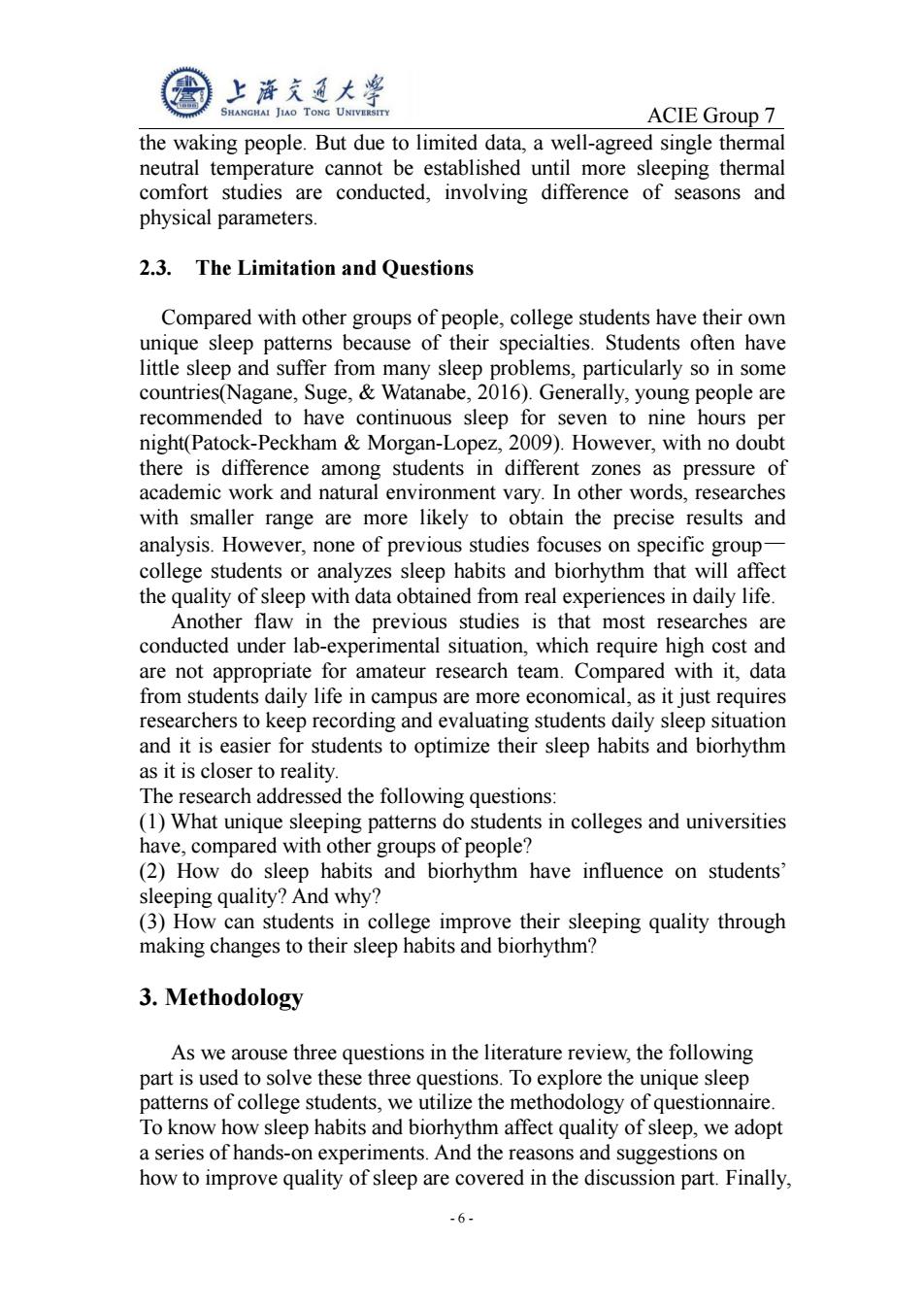
上究豆大学 SHANGHAI JIAO TONG UNIVERSIT ACIE Group 7 the waking people.But due to limited data,a well-agreed single thermal neutral temperature cannot be established until more sleeping thermal comfort studies are conducted,involving difference of seasons and physical parameters. 2.3.The Limitation and Questions Compared with other groups of people,college students have their own unique sleep patterns because of their specialties.Students often have little sleep and suffer from many sleep problems,particularly so in some countries(Nagane,Suge,Watanabe,2016).Generally,young people are recommended to have continuous sleep for seven to nine hours per night(Patock-Peckham Morgan-Lopez,2009).However,with no doubt there is difference among students in different zones as pressure of academic work and natural environment vary.In other words,researches with smaller range are more likely to obtain the precise results and analysis.However,none of previous studies focuses on specific group- college students or analyzes sleep habits and biorhythm that will affect the quality of sleep with data obtained from real experiences in daily life. Another flaw in the previous studies is that most researches are conducted under lab-experimental situation,which require high cost and are not appropriate for amateur research team.Compared with it,data from students daily life in campus are more economical,as it just requires researchers to keep recording and evaluating students daily sleep situation and it is easier for students to optimize their sleep habits and biorhythm as it is closer to reality. The research addressed the following questions: (1)What unique sleeping patterns do students in colleges and universities have,compared with other groups of people? (2)How do sleep habits and biorhythm have influence on students' sleeping quality?And why? (3)How can students in college improve their sleeping quality through making changes to their sleep habits and biorhythm? 3.Methodology As we arouse three questions in the literature review,the following part is used to solve these three questions.To explore the unique sleep patterns of college students,we utilize the methodology of questionnaire. To know how sleep habits and biorhythm affect quality of sleep,we adopt a series of hands-on experiments.And the reasons and suggestions on how to improve quality of sleep are covered in the discussion part.Finally, -6-
ACIE Group 7 - 6 - the waking people. But due to limited data, a well-agreed single thermal neutral temperature cannot be established until more sleeping thermal comfort studies are conducted, involving difference of seasons and physical parameters. 2.3. The Limitation and Questions Compared with other groups of people, college students have their own unique sleep patterns because of their specialties. Students often have little sleep and suffer from many sleep problems, particularly so in some countries(Nagane, Suge, & Watanabe, 2016). Generally, young people are recommended to have continuous sleep for seven to nine hours per night(Patock-Peckham & Morgan-Lopez, 2009). However, with no doubt there is difference among students in different zones as pressure of academic work and natural environment vary. In other words, researches with smaller range are more likely to obtain the precise results and analysis. However, none of previous studies focuses on specific group— college students or analyzes sleep habits and biorhythm that will affect the quality of sleep with data obtained from real experiences in daily life. Another flaw in the previous studies is that most researches are conducted under lab-experimental situation, which require high cost and are not appropriate for amateur research team. Compared with it, data from students daily life in campus are more economical, as it just requires researchers to keep recording and evaluating students daily sleep situation and it is easier for students to optimize their sleep habits and biorhythm as it is closer to reality. The research addressed the following questions: (1) What unique sleeping patterns do students in colleges and universities have, compared with other groups of people? (2) How do sleep habits and biorhythm have influence on students’ sleeping quality? And why? (3) How can students in college improve their sleeping quality through making changes to their sleep habits and biorhythm? 3. Methodology As we arouse three questions in the literature review, the following part is used to solve these three questions. To explore the unique sleep patterns of college students, we utilize the methodology of questionnaire. To know how sleep habits and biorhythm affect quality of sleep, we adopt a series of hands-on experiments. And the reasons and suggestions on how to improve quality of sleep are covered in the discussion part. Finally
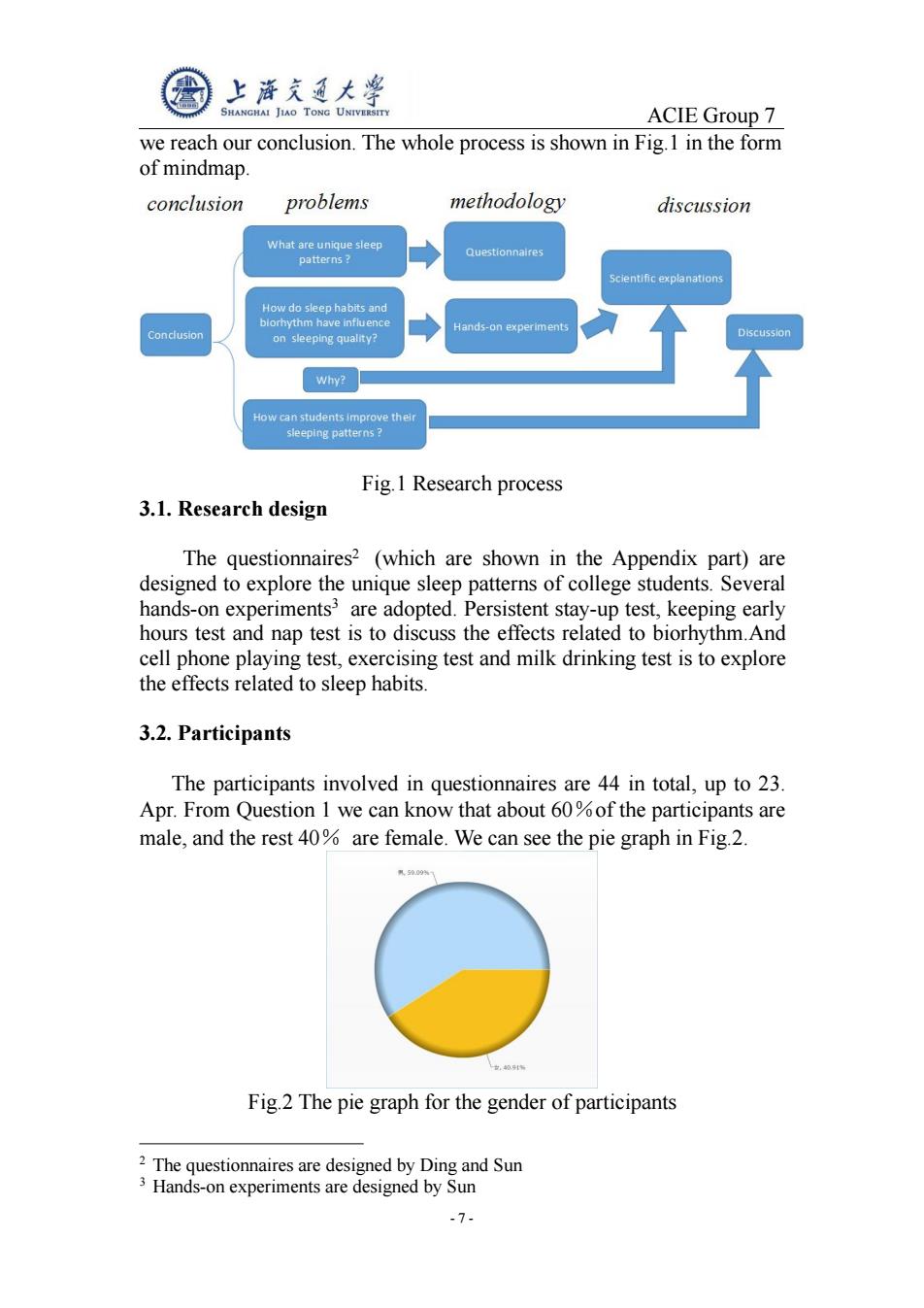
上究豆大学 SHANGHAI JIAO TONG UNIVERSIT ACIE Group 7 we reach our conclusion.The whole process is shown in Fig.1 in the form of mindmap. conclusion problems methodology discussion What are unique sleep patterns? Questionnaires Scientific explanations How do sleep habits and blorhythm have influence Hands-on experiments Conclusion on sleeping quality? Discussion why? How can students improve their sleeping patterns? Fig.1 Research process 3.1.Research design The questionnaires2 (which are shown in the Appendix part)are designed to explore the unique sleep patterns of college students.Several hands-on experiments3 are adopted.Persistent stay-up test,keeping early hours test and nap test is to discuss the effects related to biorhythm.And cell phone playing test,exercising test and milk drinking test is to explore the effects related to sleep habits. 3.2.Participants The participants involved in questionnaires are 44 in total,up to 23. Apr.From Question 1 we can know that about 60%of the participants are male,and the rest 40%are female.We can see the pie graph in Fig.2. 5009% Fig.2 The pie graph for the gender of participants 2 The questionnaires are designed by Ding and Sun 3 Hands-on experiments are designed by Sun -7-
ACIE Group 7 - 7 - we reach our conclusion. The whole process is shown in Fig.1 in the form of mindmap. Fig.1 Research process 3.1. Research design The questionnaires2 (which are shown in the Appendix part) are designed to explore the unique sleep patterns of college students. Several hands-on experiments3 are adopted. Persistent stay-up test, keeping early hours test and nap test is to discuss the effects related to biorhythm.And cell phone playing test, exercising test and milk drinking test is to explore the effects related to sleep habits. 3.2. Participants The participants involved in questionnaires are 44 in total, up to 23. Apr. From Question 1 we can know that about 60%of the participants are male, and the rest 40% are female. We can see the pie graph in Fig.2. Fig.2 The pie graph for the gender of participants 2 The questionnaires are designed by Ding and Sun 3 Hands-on experiments are designed by Sun
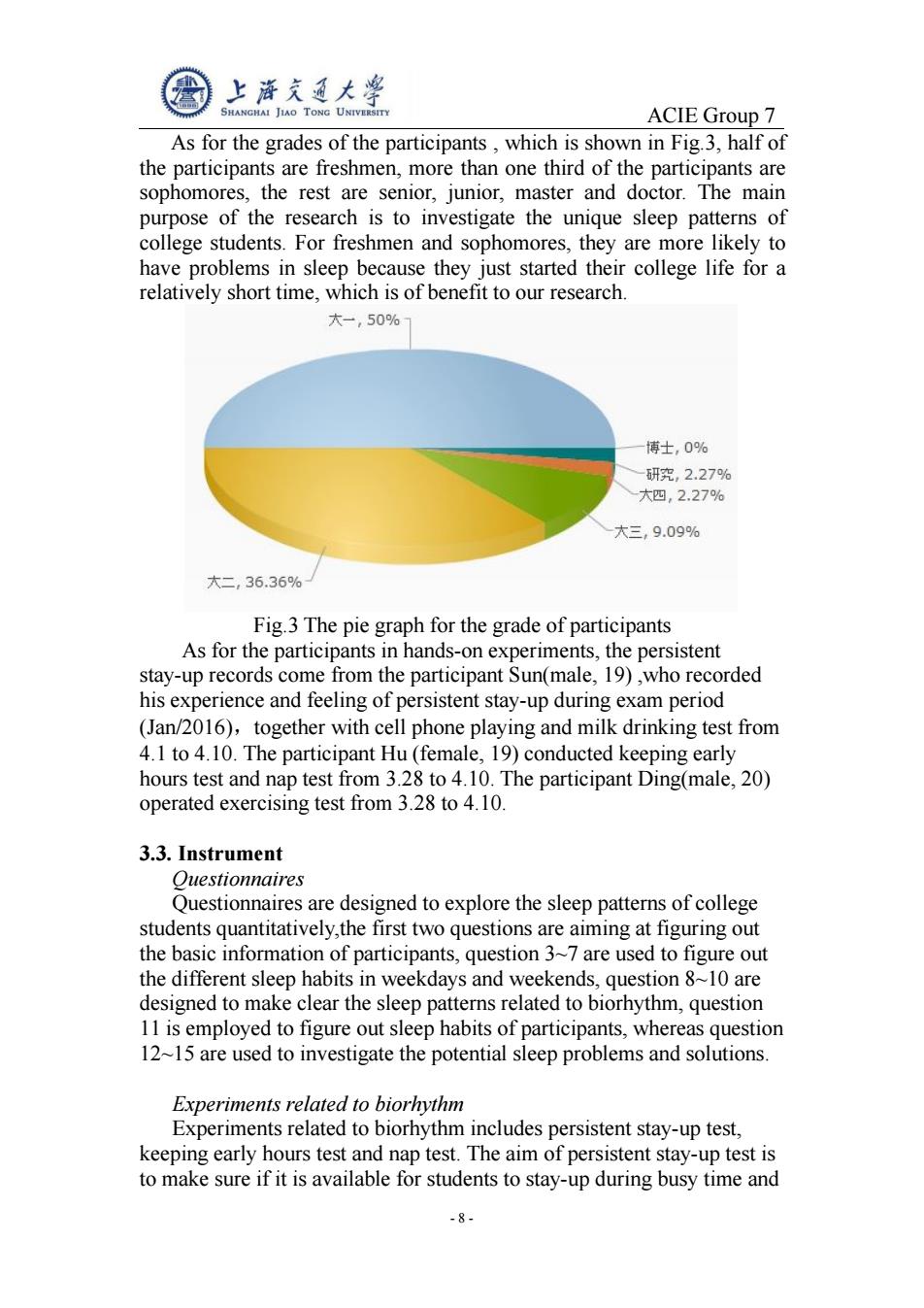
上降气通大学 SHANGHAI JIAO TONG UNIVERSIT ACIE Group 7 As for the grades of the participants,which is shown in Fig.3,half of the participants are freshmen,more than one third of the participants are sophomores,the rest are senior,junior,master and doctor.The main purpose of the research is to investigate the unique sleep patterns of college students.For freshmen and sophomores,they are more likely to have problems in sleep because they just started their college life for a relatively short time,which is of benefit to our research. 大一,50% 博士,0% 研究,2.27% 大四,2.27% 大三,9.09% 大二,36.36% Fig.3 The pie graph for the grade of participants As for the participants in hands-on experiments,the persistent stay-up records come from the participant Sun(male,19),who recorded his experience and feeling of persistent stay-up during exam period (Jan/2016),together with cell phone playing and milk drinking test from 4.1 to 4.10.The participant Hu(female,19)conducted keeping early hours test and nap test from 3.28 to 4.10.The participant Ding(male,20) operated exercising test from 3.28 to 4.10. 3.3.Instrument Questionnaires Questionnaires are designed to explore the sleep patterns of college students quantitatively,the first two questions are aiming at figuring out the basic information of participants,question 3~7 are used to figure out the different sleep habits in weekdays and weekends,question 8~10 are designed to make clear the sleep patterns related to biorhythm,question 11 is employed to figure out sleep habits of participants,whereas question 12~15 are used to investigate the potential sleep problems and solutions. Experiments related to biorhythm Experiments related to biorhythm includes persistent stay-up test, keeping early hours test and nap test.The aim of persistent stay-up test is to make sure if it is available for students to stay-up during busy time and -8-
ACIE Group 7 - 8 - As for the grades of the participants , which is shown in Fig.3, half of the participants are freshmen, more than one third of the participants are sophomores, the rest are senior, junior, master and doctor. The main purpose of the research is to investigate the unique sleep patterns of college students. For freshmen and sophomores, they are more likely to have problems in sleep because they just started their college life for a relatively short time, which is of benefit to our research. Fig.3 The pie graph for the grade of participants As for the participants in hands-on experiments, the persistent stay-up records come from the participant Sun(male, 19) ,who recorded his experience and feeling of persistent stay-up during exam period (Jan/2016),together with cell phone playing and milk drinking test from 4.1 to 4.10. The participant Hu (female, 19) conducted keeping early hours test and nap test from 3.28 to 4.10. The participant Ding(male, 20) operated exercising test from 3.28 to 4.10. 3.3. Instrument Questionnaires Questionnaires are designed to explore the sleep patterns of college students quantitatively,the first two questions are aiming at figuring out the basic information of participants, question 3~7 are used to figure out the different sleep habits in weekdays and weekends, question 8~10 are designed to make clear the sleep patterns related to biorhythm, question 11 is employed to figure out sleep habits of participants, whereas question 12~15 are used to investigate the potential sleep problems and solutions. Experiments related to biorhythm Experiments related to biorhythm includes persistent stay-up test, keeping early hours test and nap test. The aim of persistent stay-up test is to make sure if it is available for students to stay-up during busy time and

上究豆大学 SHANGHAI JIAO TONG UNIVERSIT ACIE Group 7 the effects of stay-up biorhythm.And the purpose of keeping early hours test is to figure out the effects of the habit of going to bed early and waking up early.And the intention of nap test is to affirm normal time consumption of nap and its effect to our relaxation. Experiments related to sleep habits Experiments related to sleep habits comprises of cell phone playing test,exercising test and milk drinking test.The goal of cell phone playing test is to figure out what will happen if we keep away from cell phone addiction before sleeping for the whole week.And the mission of exercising test is to make clear the effect on sleep of quality of exercising before sleep with different intensity.And the objective of milk drinking is to have a better understanding of the effect of milk on our sleep quality. 3.4.Data collection To spread the questionnaire more widely,we design the questionnaire in Chinese,which is shown in the Appendix part.As for the collection of questionnaires,we make full use of the Internet called sojump which can generate data analysis and graphs automatically.Ding released the questionnaires on the Internet on April 3,Hu and Sun helped Ding transmit the hyperlink of questionnaires to make it spread widely,and we terminated the collection on April 23.Finally,we got 44 feedback of questionnaires in total. During persistent stay-up test,participant Sun recorded his feelings and mental fluctuation in specific time period when staying up and repercussions in the next day and compared with it under normal biorhythm. During keeping early hours test(from Apr 5 to Apr 12),participant Hu persisted in going to bed earlier than normal time(22:00-22:30 compared with 23:30-24:00),waking up earlier(6:00-6:30 compared to 7:20~7:50) and doing exercise for 30 minute.And Hu recorded the adaptability,sleep quality,wakefulness state before experiment and after experiment,and its repercussions. During nap test(from Apr 12 to Apr 19),the participant Hu records the time consumption of nap and inspect the feelings after short break. During cell phone playing test(from Apr 15 to Apr 22),participant Sun recorded his adaptability,sleep quality,wakefulness state and repercussions without playing mobile before bed lasting for whole week. During exercising test,the participant Ding conducted different intensity of exercise(stroll,1200m running and 3000m running)and the quality of sleep and repercussions during the process of experiment were recorded -9-
ACIE Group 7 - 9 - the effects of stay-up biorhythm.And the purpose of keeping early hours test is to figure out the effects of the habit of going to bed early and waking up early. And the intention of nap test is to affirm normal time consumption of nap and its effect to our relaxation. Experiments related to sleep habits Experiments related to sleep habits comprises of cell phone playing test, exercising test and milk drinking test. The goal of cell phone playing test is to figure out what will happen if we keep away from cell phone addiction before sleeping for the whole week. And the mission of exercising test is to make clear the effect on sleep of quality of exercising before sleep with different intensity. And the objective of milk drinking is to have a better understanding of the effect of milk on our sleep quality. 3.4. Data collection To spread the questionnaire more widely, we design the questionnaire in Chinese, which is shown in the Appendix part. As for the collection of questionnaires, we make full use of the Internet called sojump which can generate data analysis and graphs automatically. Ding released the questionnaires on the Internet on April 3, Hu and Sun helped Ding transmit the hyperlink of questionnaires to make it spread widely, and we terminated the collection on April 23. Finally, we got 44 feedback of questionnaires in total. During persistent stay-up test, participant Sun recorded his feelings and mental fluctuation in specific time period when staying up and repercussions in the next day and compared with it under normal biorhythm. During keeping early hours test(from Apr 5 to Apr 12), participant Hu persisted in going to bed earlier than normal time (22:00-22:30 compared with 23:30-24:00), waking up earlier(6:00-6:30 compared to 7:20~7:50) and doing exercise for 30 minute. And Hu recorded the adaptability, sleep quality, wakefulness state before experiment and after experiment, and its repercussions. During nap test(from Apr 12 to Apr 19), the participant Hu records the time consumption of nap and inspect the feelings after short break. During cell phone playing test(from Apr 15 to Apr 22), participant Sun recorded his adaptability, sleep quality, wakefulness state and repercussions without playing mobile before bed lasting for whole week. During exercising test, the participant Ding conducted different intensity of exercise (stroll, 1200m running and 3000m running) and the quality of sleep and repercussions during the process of experiment were recorded